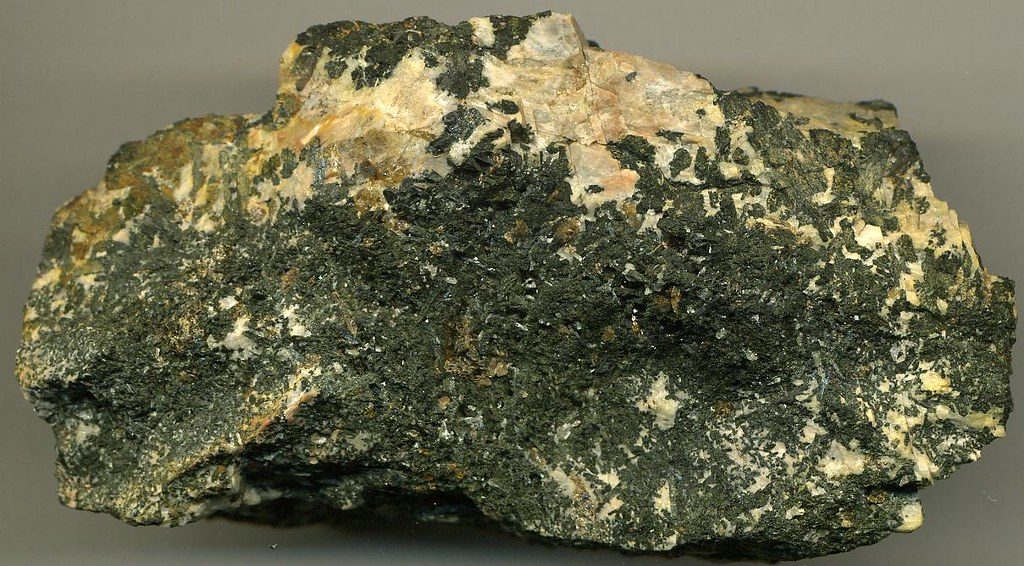




Microcline is one of the most common feldspar minerals. It can be colorless, white, cream to pale yellow, salmon pink to red, or bright green to blue-green. Microcline forms short prismatic or tabular crystals that are often of considerable size: single crystals can weigh several tons and reach yards in length. Crystals are often multiply twinned, with two sets of fine lines at right angles to each other. This gives a “plaid” effect that is unique to microcline among the feldspars. Microcline can also be massive. The mineral occurs in feldspar-rich rocks, such as granite, syenite, and granodiorite. It is found in granite pegmatites and in metamorphic rocks, such as gneisses and schists.
Polymorphism & Series: Dimorphous with orthoclase.
Mineral Group: Feldspar (alkali) group; (Si,Al) is completely ordered in low microcline.
Chemical Properties of Microcline
| Chemical Classification | Silicate |
| Chemical Composition | K(AlSi3O8) |
Physical Properties of Microcline
| Color | White, grey, greyish yellow, yellowish, tan, salmon-pink, bluish green, green. |
| Streak | White |
| Luster | Vitreous |
| Cleavage | Perfect on [001], good on [010] |
| Diaphaneity | Transparent, Translucent |
| Mohs Hardness | 6 – 6½ on Mohs scale |
| Specific Gravity | 2.54 – 2.57 |
| Crystal System | Triclinic |
| Tenacity | Brittle |
| Parting | on {100}{110}{110}{201} |
| Fracture | Irregular/Uneven |
| Density | 2.54 – 2.57 g/cm3 (Measured) 2.56 g/cm3 (Calculated) |
Optical Properties of Microcline

| Type | Anisotropic |
| Optical Extinction | Inclined extinction to cleavage |
| Twinning | Carlsbad, Baveno, Manebach, polysynthetic on albite and pericline laws. |
| Optic Sign | Biaxial (-) |
| Birefringence | δ = 0.007 – 0.010 |
| Relief | Low |
Occurrence
Common in plutonic felsic rocks, as granites, granite pegmatites, syenites; in metamorphic rocks of the greenschist and amphibolite facies; in hydrothermal veins. A detrital component in sedimentary rocks and as authigenic overgrowths.
Uses Areas
- The most important place of use is the production of porcelain.
- Microcline is used industrially in the production of glass and ceramic products.
- It is used as ornamental lapidary material with Amazonite in green color.
- Sometimes feldspar is also used in the manufacture of glass.
Association
Quartz, sodic plagioclase, muscovite, biotite, hornblende.
Distribution
A widespread mineral. Notable occurrences include:
- at FredriksvÄarn, Arendal, and Larvik, Norway.
- In the Ilmen Mountains, Ural Mountains, and on the Kola Peninsula, Russia.
- At St. Gotthard, Ticino, Switzerland.
- On Mt. Greiner, Zillertal, Tirol, Austria.
- At Baveno, Piedmont, Italy.
- In the USA, at Amelia, Amelia Co., Virginia; Haddam, Middlesex Co., Connecticut; and Magnet Cove, Hot Spring Co., Arkansas.
- In Colorado, in the Pikes Peak area, El Paso Co., Crystal Peak, Teller Co., with large crystals from the Devil’s Hole beryl mine, Fremont Co.; in the Black Hills, Pennington and Custer Cos., South Dakota.
- At Bancroft, Ontario, Canada.
- From Klein Spitzkopje, Namibia.
- In Brazil, from Minas Gerais, at Fazenda do Bananal, Salinas, Urucum, and Capelinha.
- At Ambositra, Madagascar.
- From Kimpusan, Yamanshi Prefecture, and Tanakamiyama, Otsu, Shiga Prefecture, Japan.
- At Broken Hill, New South Wales, Australia.
References
- Bonewitz, R. (2012). Rocks and minerals. 2nd ed. London: DK Publishing.
- Handbookofmineralogy.org. (2019). Handbook of Mineralogy. [online] Available at: http://www.handbookofmineralogy.org [Accessed 4 Mar. 2019].
- Mindat.org. (2019). Microcline: Mineral information, data and localities.. [online] Available at: https://www.mindat.org




































